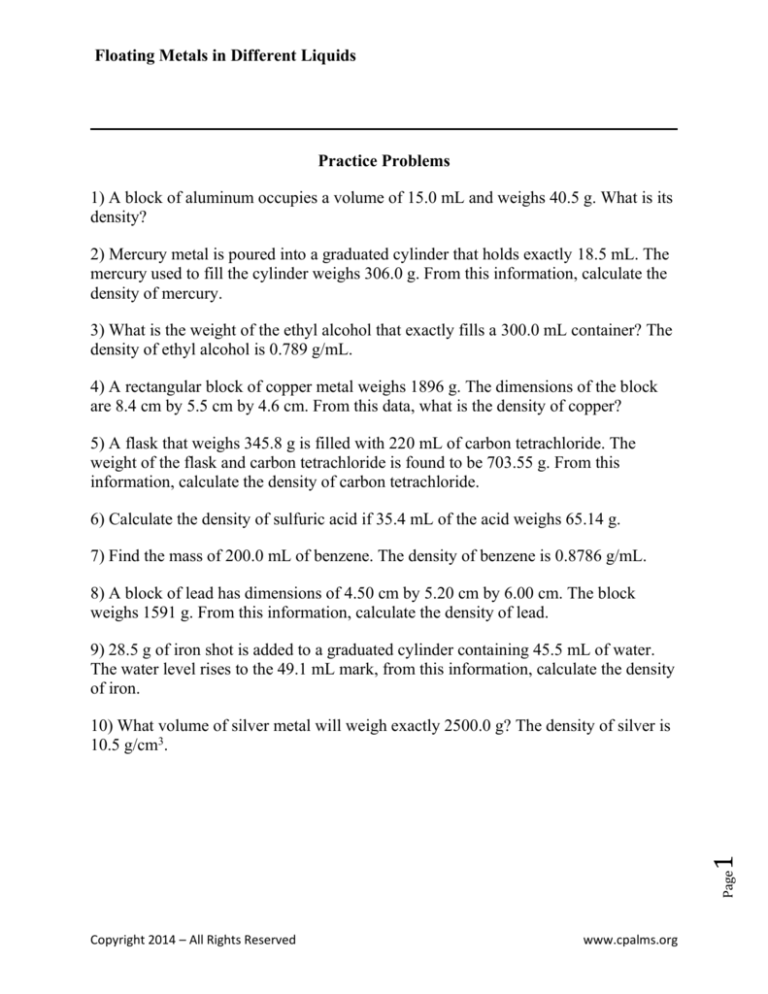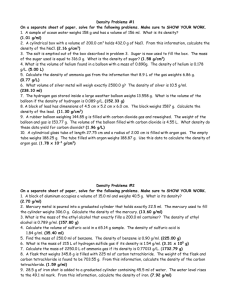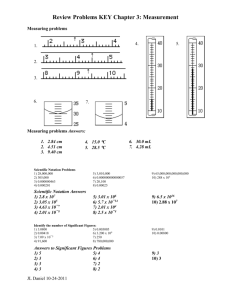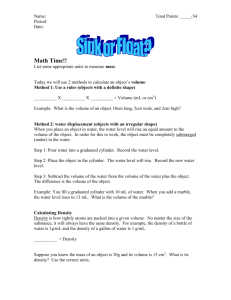
Floating Metals in Different Liquids
Practice Problems
1) A block of aluminum occupies a volume of 15.0 mL and weighs 40.5 g. What is its
density?
2) Mercury metal is poured into a graduated cylinder that holds exactly 18.5 mL. The
mercury used to fill the cylinder weighs 306.0 g. From this information, calculate the
density of mercury.
3) What is the weight of the ethyl alcohol that exactly fills a 300.0 mL container? The
density of ethyl alcohol is 0.789 g/mL.
4) A rectangular block of copper metal weighs 1896 g. The dimensions of the block
are 8.4 cm by 5.5 cm by 4.6 cm. From this data, what is the density of copper?
5) A flask that weighs 345.8 g is filled with 220 mL of carbon tetrachloride. The
weight of the flask and carbon tetrachloride is found to be 703.55 g. From this
information, calculate the density of carbon tetrachloride.
6) Calculate the density of sulfuric acid if 35.4 mL of the acid weighs 65.14 g.
7) Find the mass of 200.0 mL of benzene. The density of benzene is 0.8786 g/mL.
8) A block of lead has dimensions of 4.50 cm by 5.20 cm by 6.00 cm. The block
weighs 1591 g. From this information, calculate the density of lead.
9) 28.5 g of iron shot is added to a graduated cylinder containing 45.5 mL of water.
The water level rises to the 49.1 mL mark, from this information, calculate the density
of iron.
Page
1
10) What volume of silver metal will weigh exactly 2500.0 g? The density of silver is
10.5 g/cm3.
Copyright 2014 – All Rights Reserved
www.cpalms.org
Floating Metals in Different Liquids
ANSWER KEY
1) A block of aluminum occupies a volume of 15.0 mL and weighs 40.5 g. What is its
density?
d = 40.5 g / 15.0 mL
d = 2.7 g/mL
2) Mercury metal is poured into a graduated cylinder that holds exactly 22.5 mL. The
mercury used to fill the cylinder weighs 306.0 g. From this information, calculate the
density of mercury.
d = 306.0 g / 18.5 mL
d = 16.5 g/mL
3) What is the weight of the ethyl alcohol that exactly fills a 200.0 mL container? The
density of ethyl alcohol is 0.789 g/mL.
d = g / mL
g = (d) (mL)
g = (0.789 g/mL) (300.0 mL) = 236.7 g
4) A rectangular block of copper metal weighs 1896 g. The dimensions of the block
are 8.4 cm by 5.5 cm by 4.6 cm. From this data, what is the density of copper?
(8.4 cm) (5.5 cm) (4.6 cm) = 212.52 cm3
Copyright 2014 – All Rights Reserved
www.cpalms.org
Page
Significant figures in the answer are dictated by the length measurements of two sig
figs.
2
d = 1896 g / 212.52 cm3 = 8.9 g/cm3
Floating Metals in Different Liquids
5) A flask that weighs 345.8 g is filled with 225 mL of carbon tetrachloride. The
weight of the flask and carbon tetrachloride is found to be 703.55 g. From this
information, calculate the density of carbon tetrachloride.
mass of CCl4 = 703.55 g - 345.8 g = 357.75 g
d = 357.75 g / 220 mL = 1.63 g/mL
6) Calculate the density of sulfuric acid if 35.4 mL of the acid weighs 65.14 g.
d = 65.14 g / 35.4 mL
d = 1.84 g/mL
7) Find the mass of 200.0 mL of benzene. The density of benzene is 0.8786 g/mL.
density = mass ÷ volume; therefore mass = (density) (volume)
mass = (0.8786 g/mL) (200.0 mL) = 175.72 g (rounded to 4 sig fig)
8) A block of lead has dimensions of 4.50 cm by 5.20 cm by 6.00 cm. The block
weighs 1591 g. From this information, calculate the density of lead.
determine the volume of the lead block: (4.50 cm) (5.20 cm) (6.00 cm) = 140.4
cm3 (ignore sig figs for the moment)
Page
3
calculate density: 1591 g / 140.4 cm3 = 11.3 g/cm3 (3 sig figs because of the length
measurements on the lead block)
Copyright 2014 – All Rights Reserved
www.cpalms.org
Floating Metals in Different Liquids
9) 28.5 g of iron shot is added to a graduated cylinder containing 45.5 mL of water.
The water level rises to the 49.1 mL mark, From this information, calculate the
density of iron.
volume of iron shot = 49.1 mL - 45.5 mL = 3.6 mL
d = 28.5 g / 3.6 mL
d = 7.9 g/mL
10) What volume of silver metal will weigh exactly 2500.0 g. The density of silver is
10.5 g/cm3.
d = g / cm3
cm3 = g / d
cm3 = 2500.0 g / (10.5 g/cm3) = 238 cm3
Page
4
Note that, in the g/cm3 unit, that the cm3 is in the denominator of the denominator. It
moves to the numerator, giving us the volume unit we desire for the answer.
Copyright 2014 – All Rights Reserved
www.cpalms.org










